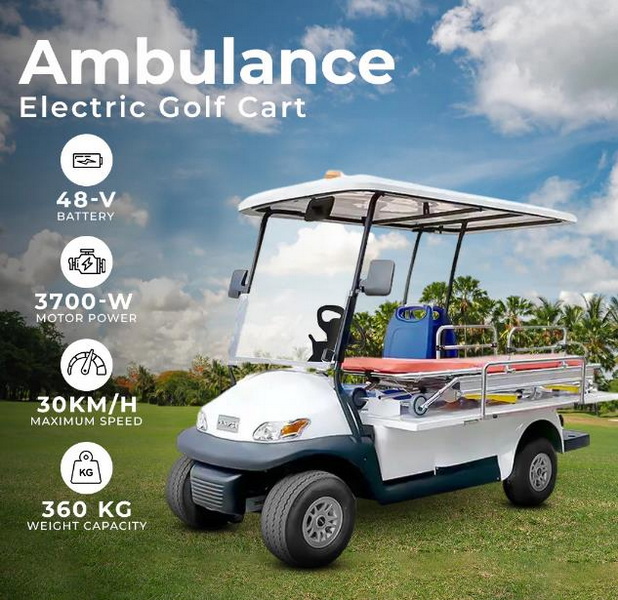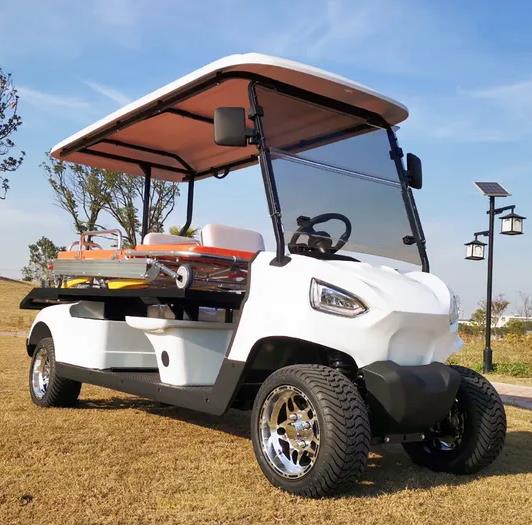Content Menu
● Introduction to Electric Ambulance Carts
>> Key Features of Electric Ambulance Carts
● Advantages of Electric Ambulance Carts
>> Environmental Benefits
>> Operational Efficiency
>> Enhanced Maneuverability
>> Improved Patient and Paramedic Experience
● Case Studies: Successful Implementation of Electric Ambulance Carts
>> Example 1: Kenya's MTRH Hospital
>> Example 2: London Ambulance Service
● Challenges and Future Directions
>> Overcoming Challenges
● Expanding Applications
>> Non-Emergency Use Cases
● Conclusion
● FAQs
>> 1. What are the environmental benefits of electric ambulance carts?
>> 2. How do electric ambulance carts improve patient care?
>> 3. What are the operational cost savings of electric ambulance carts?
>> 4. Can electric ambulance carts be customized with medical equipment?
>> 5. Are electric ambulance carts suitable for indoor and outdoor use?
The healthcare sector is undergoing a significant transformation with the integration of electric vehicles, particularly in emergency medical services. Electric ambulance carts have emerged as a revolutionary alternative to traditional ambulances, offering numerous benefits that enhance patient care, reduce environmental impact, and improve operational efficiency. In this article, we will explore the top reasons why electric ambulance carts are gaining preference over traditional options.

Introduction to Electric Ambulance Carts
Electric ambulance carts are specialized vehicles designed for emergency medical transport, especially in settings where traditional ambulances may be impractical. These carts are powered by electric motors and rechargeable batteries, providing a cleaner, quieter, and more efficient alternative to conventional ambulances.
Key Features of Electric Ambulance Carts
1. Electric Propulsion: These carts are driven by advanced electric motors, offering zero emissions, quieter operation, and lower maintenance requirements compared to internal combustion engines.
2. Compact Design: Electric ambulance carts are smaller and more maneuverable than traditional ambulances, making them ideal for navigating tight spaces in urban areas or large indoor facilities.
3. Customizable Medical Equipment: Despite their compact size, these carts can be equipped with essential medical equipment such as vital monitoring devices, oxygen supply systems, and storage for medications.
4. Versatility: They serve multiple purposes, including rapid response vehicles, patient transport units within facilities, or support vehicles in mass casualty incidents.
5. Eco-Friendly Operation: By utilizing electric power, these carts significantly reduce the carbon footprint associated with emergency medical services.
Advantages of Electric Ambulance Carts
Environmental Benefits
- Zero Emissions: Electric ambulance carts produce no tailpipe emissions, contributing to cleaner air quality and reducing pollution in urban environments.
- Reduced Noise Pollution: The quiet operation of electric carts minimizes disturbance in sensitive areas such as hospitals or residential neighborhoods.
- Lower Carbon Footprint: By eliminating the need for fossil fuels, these carts help healthcare organizations reduce their overall carbon emissions.
Operational Efficiency
- Lower Operating Costs: Electric vehicles generally have lower fuel and maintenance costs compared to gasoline-powered counterparts. Electricity is cheaper than gasoline or diesel, allowing for substantial savings on fuel expenses.
- Simplified Maintenance: With fewer moving parts and no need for oil changes, electric ambulance carts require less frequent and less complex maintenance.
- Quick Charging: Modern battery technology allows for rapid charging, ensuring the carts are ready for service with minimal downtime.
Enhanced Maneuverability
- Compact Size: The smaller footprint of electric ambulance carts allows them to navigate through tight spaces and crowded areas more easily than full-sized ambulances.
- Precise Control: Electric motors provide instant torque and smooth acceleration, offering better control in various driving conditions.
- Indoor/Outdoor Versatility: These carts are equally effective in indoor settings like airports or shopping malls and outdoor environments such as parks or sports venues.
Improved Patient and Paramedic Experience
- Smoother Ride: Electric propulsion systems typically provide a smoother, more comfortable ride for patients and medical staff.
- Reduced Vibration: The absence of a combustion engine means less vibration, creating a more stable environment for patient care and sensitive medical equipment.
- Better Air Quality: With no exhaust emissions, the air quality around the vehicle is improved, benefiting patients with respiratory conditions and the attending medical personnel.

Case Studies: Successful Implementation of Electric Ambulance Carts
Example 1: Kenya's MTRH Hospital
In Kenya, the Moi Teaching and Referral Hospital (MTRH) in Eldoret has successfully implemented an electric golf cart mini ambulance. This vehicle is used to transport critically ill patients within the hospital premises, providing a quiet and comfortable ride. The use of this electric cart has significantly reduced the workload on nurses who previously had to manually move patients, and it has also contributed to environmental sustainability by using rechargeable batteries.
Example 2: London Ambulance Service
The London Ambulance Service has introduced a fully electric ambulance, which has been in operation since New Year's Eve 2023. This pioneering vehicle has demonstrated its reliability and efficiency in responding to emergencies across London, with paramedics praising its environmental benefits and smooth operation.
Challenges and Future Directions
Despite the numerous advantages, there are challenges associated with the widespread adoption of electric ambulance carts, such as the need for improved charging infrastructure and higher initial costs. However, advancements in battery technology and government incentives are addressing these issues.
Overcoming Challenges
1. Infrastructure Development: Governments and private companies are investing in expanding charging networks, ensuring that electric vehicles have access to reliable power sources.
2. Economic Incentives: Many countries offer tax credits or subsidies for organizations transitioning to electric vehicles, helping offset the higher upfront costs.
3. Technological Advancements: Continuous improvements in battery technology are increasing the range and efficiency of electric vehicles, making them more viable for emergency services.
4. Public Awareness: Educating the public about the benefits of electric ambulance carts can foster support and encourage further adoption.
5. Collaborative Innovation: Collaboration between healthcare providers, technology companies, and governments is crucial for developing tailored solutions that meet the unique needs of emergency medical services.
Expanding Applications
Electric ambulance carts are not limited to traditional emergency response scenarios. They can also be used in non-emergency situations such as transporting patients within large medical facilities or providing medical support at public events.
Non-Emergency Use Cases
1. Event Medical Support: Electric carts can serve as mobile medical units at festivals, marathons, or other large gatherings, providing quick and efficient medical care.
2. Facility Transport: Within hospitals or large healthcare complexes, these carts can transport patients between departments, reducing the need for manual transport and improving efficiency.
3. Community Outreach: Electric ambulance carts can be used for community health initiatives, such as mobile clinics or health fairs, offering accessible healthcare services in remote or underserved areas.
4. Disaster Response: In disaster scenarios, electric carts can navigate through debris-filled areas more easily than larger vehicles, providing critical medical support in challenging environments.
5. Training and Education: These carts can be used in medical training exercises, allowing paramedics to practice emergency procedures in a controlled environment.
Conclusion
Electric ambulance carts represent a significant step forward in emergency medical services, offering a cleaner, quieter, and more efficient alternative to traditional ambulances. Their environmental benefits, operational efficiency, and improved patient care make them an attractive choice for healthcare providers looking to modernize their services.

FAQs
1. What are the environmental benefits of electric ambulance carts?
Electric ambulance carts produce zero tailpipe emissions, reducing air pollution and contributing to a cleaner environment. They also minimize noise pollution, making them ideal for urban and residential areas.
2. How do electric ambulance carts improve patient care?
These carts provide a smoother and quieter ride, which is particularly beneficial for fragile patients. The reduced vibration and noise help paramedics operate sensitive medical equipment more effectively.
3. What are the operational cost savings of electric ambulance carts?
Electric ambulance carts have lower fuel costs since they run on electricity, which is generally cheaper than gasoline or diesel. They also require less maintenance due to fewer moving parts.
4. Can electric ambulance carts be customized with medical equipment?
Yes, electric ambulance carts can be equipped with essential medical equipment such as vital monitoring devices, oxygen supply systems, and storage for medications, despite their compact size.
5. Are electric ambulance carts suitable for indoor and outdoor use?
Yes, these carts are versatile and can be used both indoors, such as in hospitals or shopping malls, and outdoors in environments like parks or sports venues.










































